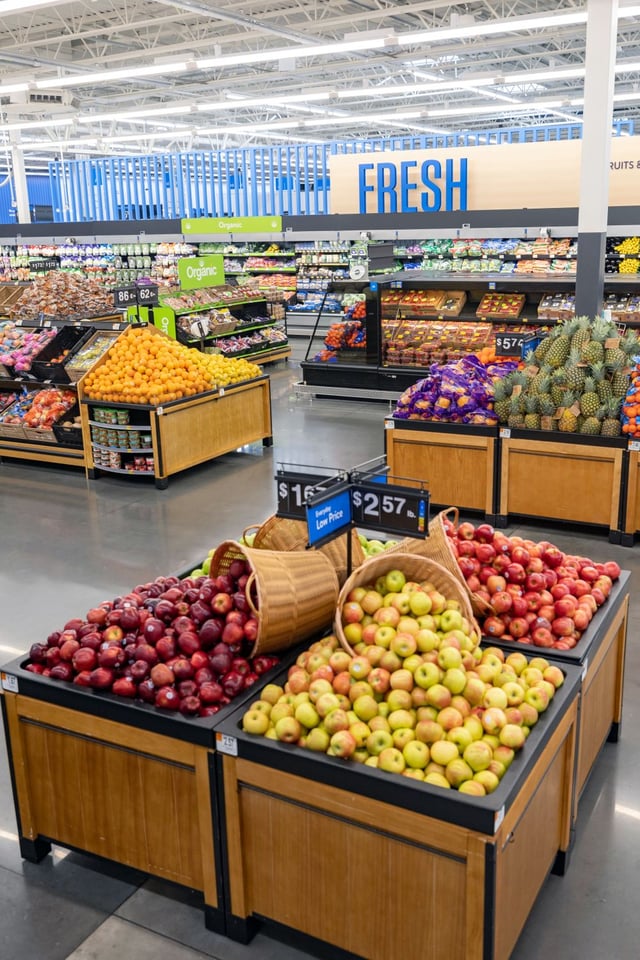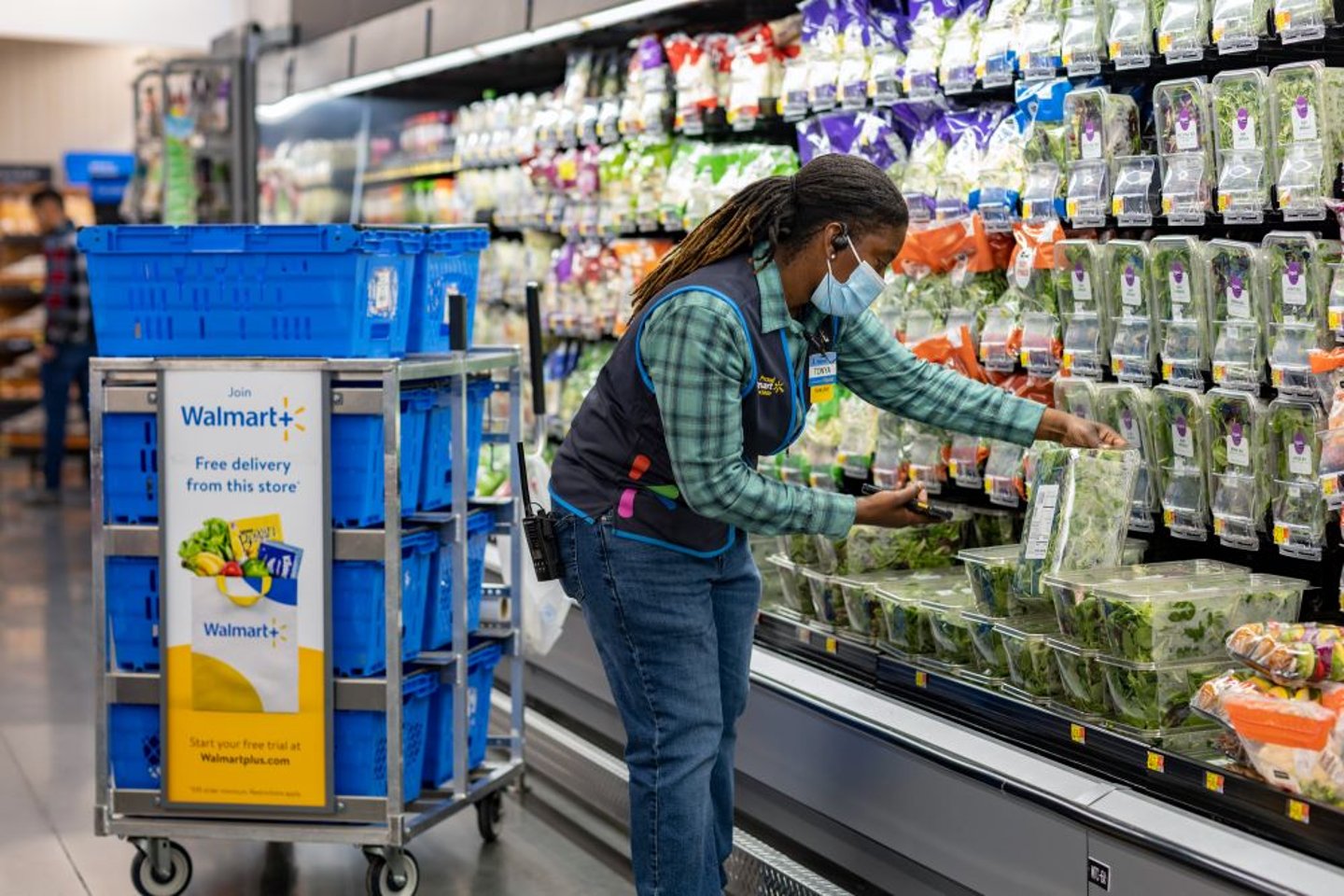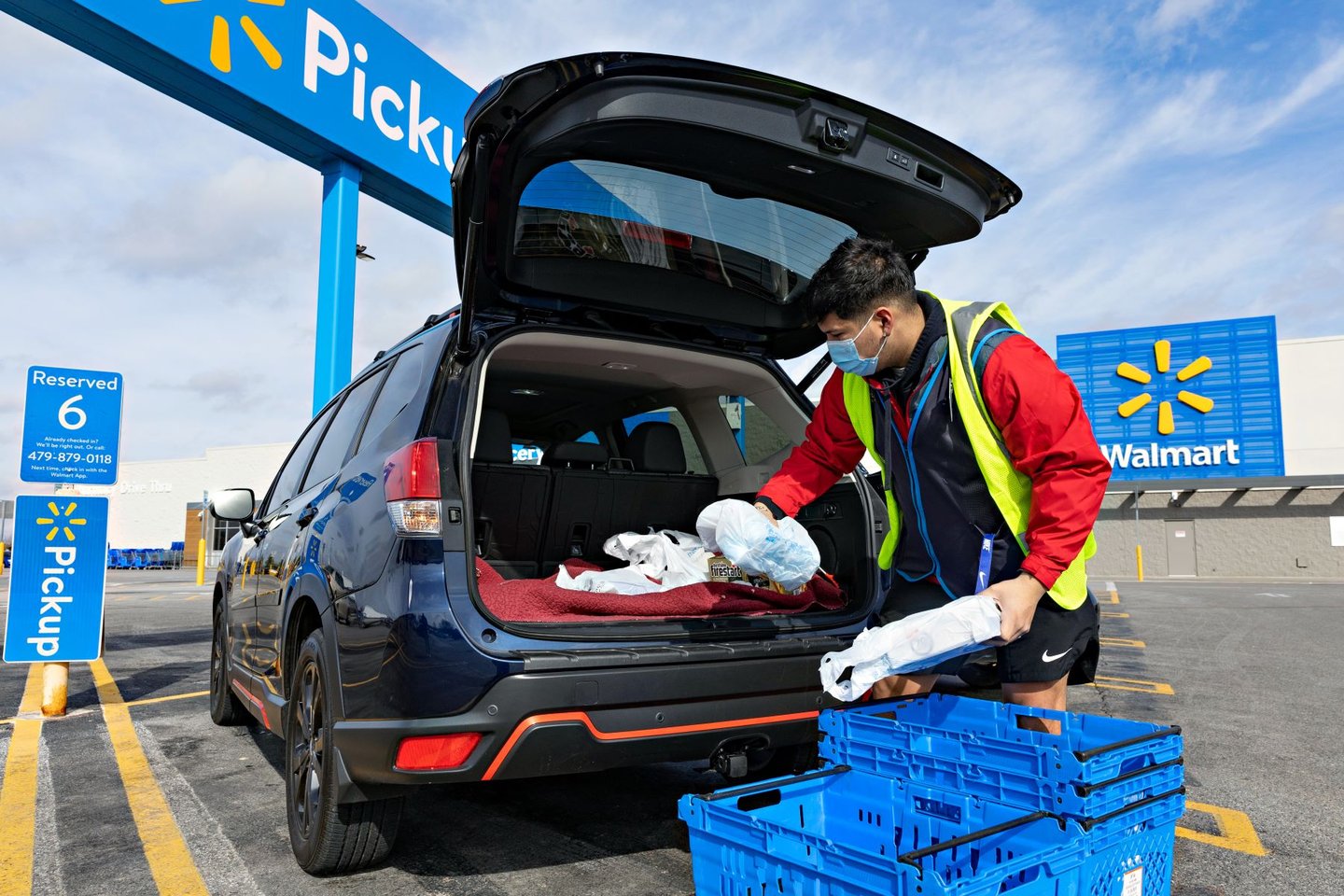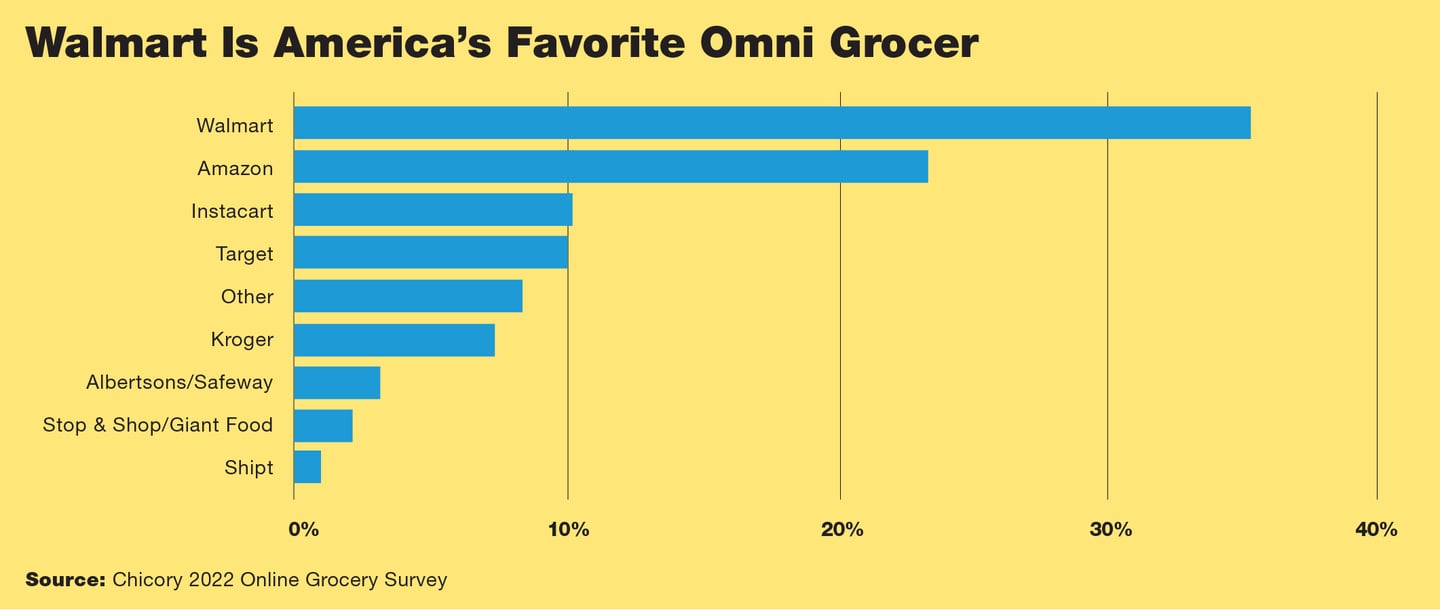Walmart Just Getting Started on Disrupting Grocery
With the rate of inflation in the United States at a 40-year high of 7.5%, and geopolitical strife threatening to take prices even higher, there are only a handful of grocery retailers in a unique position to leverage these crises into drivers of business. At the top of that list of food retailers is Walmart.
“During periods of inflation like this, middle-income families, lower-middle-income families, even wealthier families become more price sensitive, and that’s to our advantage,” Walmart CEO Doug McMillon said during the company’s fourth-quarter earnings call in February. “So we’ve been through this before, and we run with inflation around the world all the time. But inflation is a different environment in the U.S. right now than it has been in recent times, for sure.”
Especially in hard times, Walmart keeps growing. As the Bentonville, Ark.-based retailer prepares to celebrate its 60th birthday this year, it’s just getting started on a whole new business model perfectly suited for these hard times and poised to drive even more growth: one that leverages the company’s multibillion-dollar investments in store experience, product assortment, digital convenience and sustainability.
Walmart Chief Merchandising Officer Charles Redfield offers Progressive Grocer an exclusive glimpse what’s next for the company that already sells more groceries in the United States than any other retailer.
“We may be the largest, but we also want to be the best and the customer’s first choice,” Redfield says. “We do that by evolving and innovating. We are innovating across our stores, supply chain and customer experience to ensure we exceed their expectations on however and whenever they want to shop. We’ll continue to evolve and innovate for the future. Our continued commitment is to always provide our customers with fresh, high-quality food items at the everyday low prices they expect, no matter how they shop.”
Variety Redefined
At first glance, Walmart at the age of 60 might not look all that much different from the shop that founder Sam Moore Walton first opened in the 1940s in Newport, Ark.
From 1945 until the 1960s, Walton’s retailing business was devoted entirely to the operation of variety stores. In 1962, he opened the first Walmart store under the original flywheel business model of “Always Low Prices.” In 1974, the company updated that strategy to “Every Day Low Prices.”
Today, the Walmart of 2022 is still focused on low prices and variety, albeit on a much grander and more modern scale. Under a new flywheel business model revealed last year, the company is scaling a whole other variety of businesses, from delivering groceries straight to customers’ refrigerators, to new media, to home repair services, to data monetization, to fulfillment services, to white-label solutions for other retailers, even as it continues to grow sales from its massive physical-store footprint.
Walmart began selling groceries in 1988, the same year that it opened its first Supercenter and a few years after it opened its first Sam’s Club. In 1998, it opened its first Walmart Neighborhood Market. Walmart now generates about 60% of its revenue from selling food and consumables across a footprint of 5,342 locations; according to a new 2022 report from Chicago-based Numerator, Walmart commands 18% of the grocery market share in the United States. The company with $559 billion in annual revenue now has 3,573 Supercenters (around 178,000 square feet each); 370 discount stores (around 106,000 square feet each); 683 Neighborhood Market stores (around 42,000 square feet each); 116 small-format stores; and 600 Sam’s Clubs, a network of stores that gives the retailer a unique competitive advantage, Redfield notes.
“There is strong competition in the grocery industry,” he says. “But with 90% of Americans living within 10 miles of a Walmart, we have a very good understanding of how America shops, which allows us to adjust our offerings to reflect the needs of most of the country, setting us apart from other retailers.”
“Adjusting its offerings” is an understatement of what Walmart has been doing during one of the most challenging periods in retail history. The company has been spending billions of dollars on customer-facing initiatives and technology while leveraging its heft with suppliers to navigate supply chain bottlenecks and soaring costs, and shoppers are responding by packing Walmart stores. During its fourth quarter ended Jan. 28, U.S. same-store sales (excluding fuel) at Walmart were up 5.6%; comps were up 14.2% on a two-year-stack basis. The retailer said that comps reflected strong in-store traffic aided by robust consumer spending and a strong holiday season, despite the Omicron surge. Traffic was up 3.1% during the quarter, and average ticket was up 2.4%.
Walmart is grabbing even more grocery share. Its grocery comps increased by the high single digits in its fourth quarter, with sales growth and market share gains aided by slightly wider price gaps than pre-pandemic levels and expanded digital offerings; on a two-year stack, sales increased by a mid-teens percentage. Food categories increased by a high-teens percentage on a two-year stack. Meanwhile, grocery led sales growth at Sam’s Club during the quarter. The warehouse club chain’s comps increased 10.4%, and 21.2% on a two-year stack. The banner’s food categories led growth, with freezer/cooler comp growth in the low teens. Fresh meat, produce, floral and prepared foods also performed well, the company said, with dry grocery and beverage comps also showing strength. Walmart reported net income of $3.56 billion, or $1.28 per share, compared with a loss of $2.09 billion, or 74 cents per share, a year earlier. Total revenue rose slightly to $152.87 billion, from $152.08 billion a year earlier. For the full fiscal 2021, total revenue was $572.8 billion, up 2.4%.
During the quarter, Walmart remodeled more than 140 stores; it plans to remodel 600 locations in fiscal 2022. The remodels include a new store layout that Redfield says is designed to make Walmart a primary destination for more shoppers.
“Last year, we announced the first phase of our store redesign that was focused on navigation and wayfinding,” he observes. “In January, we unveiled the next phase for our signature experience, which we call ‘Time Well Spent.’ It focuses on making Walmart a destination where customers want to spend their time.”
Time Well Spent
For millions of consumers, Walmart’s ubiquitous stores are the reason that they love the company. They’re also the retailer’s biggest competitive advantage, especially now, when the American consumer is longing to return to in-store shopping after two years of a stressful pandemic, Redfield points out.
“Customers are still craving an in-store experience, which we have seen steadily rise back towards pre-pandemic levels,” he says. “We think the rollout of the second phase of our store redesign will continue to entice customers to come into stores, since we are repositioning Walmart as a destination where customers will want to spend their time.”
Last year, the retailer launched a store design focused on a digitally enabled shopping experience. Developed through a customer-centric lens, the store aims to create an elevated experience that appeals to shoppers through a sleek design aesthetic, a layout that spotlights products, and end-to-end digital navigation that guides customers throughout their journeys.
The company updated the exterior and interior signage of stores to reflect the Walmart app icon, hoping to create an instant omni-shopping experience in the customer’s mind. As customers enter the store, they are greeted with a store directory that encourages them to download and use the Walmart app while they shop. Throughout the store, bold dimensional typeface — e.g., FRESH, BEEF and DAIRY — directs customers to the exact section that they’re looking for, while aisles are marked with letter-and-number combinations to guide customers from phone to product. Stores were also outfitted with self-checkout kiosks as well as contactless payment solutions, including Walmart Pay. Select locations will also feature Scan & Go to help customers manage checkout directly.
According to Walmart, the feedback that it has received from customers regarding the new layout has been overwhelmingly positive, and it now has close to 1,000 stores with the first phase of the redesign installed.
This year, the company is embarking on a second phase of the redesign — the aforementioned Time Well Spent — which is laser-focused on earning primary-destination status from the shopper. Features of the new design, now playing a starring role at the company’s incubator Store No. 4108 in Springdale, Ark., include displays at the corners of departments pulling customers in and helping them touch, feel and become a part of the space; brand shops offering a next-gen “store-within-a-store experience,” and omni touchpoints such as QR codes and digital screens. For example, in the pet department, a customer may scan a QR code to find additional dog bed options, learn about Walmart’s pet insurance service options or have a 20-pound bag of kibble delivered to their door.
On the foodservice front, last year the retailer opened more than 400 new restaurants as part of the redesign, including 30-plus new brands introduced to Walmart, most of them local or regional offerings.
“Both in-store and online, we have made it easier to navigate, order, check out, and pick up or deliver the items our customers need most, especially in today’s ever-changing climate,” Redfield says. “The bar for ‘easy’ pushes higher every day, and customers are expecting us to continue to meet it.”
Hyper-Localized
As for the merchandising strategy behind all of these newly redesigned Walmarts, Redfield asserts that “hyper-localization” remains key to the retailer’s strategy going forward.
“We don’t view the customers of all our stores as one, singular Walmart customer; we look at the local community and view each customer as unique — across all our categories,” he says. “We create what we call hyper-localization by catering to local tastes and preferences. We are in many communities across the country, but we are able to take a local approach to many items. We have an extremely large and targeted selection of diverse/ethnic grocery items across multiple categories. It’s all about providing great, innovative high-quality items, meeting the customer’s needs and making their store feel like home.”
Although the retailer’s merchandising strategy, product assortment and promotions may vary by location, Redfield notes that Walmart knows its customers across the country are always interested in high-quality products at affordable prices. That’s why the company has been also focused on growing its private-brands program.
“For grocery, our private brands, including Great Value and Marketside, continue to be a place where we innovate and bring products to market that we know our customers will love,” he says. “Private brand plays a very important role in our grocery portfolio. Great Value and Marketside are an integral part of our customer’s shopping basket, particularly as they provide great quality and value.”
The chief merchant observes that the company is always looking for on-trend flavors and exciting foods. It also listens to customers to develop new products, bring them to market quickly and offer them at a price that shoppers expect from Walmart. According to Redfield, recent growth categories include do-it-yourself cooking items, baking products and fresh food.
“We continue to see a big opportunity to continue to capture inspirational moments in our seasonal offerings in snacking, sweets and entertaining, and are consistently growing our assortment of private brand across all categories,” he says. “Our customers love our private brands because they deliver on taste and quality, while still being affordable additions to the weekly grocery trip. Customers are choosing our private brands more often, driving double-digit growth since 2020.”
Redfield observes that Walmart is introducing new items across grocery categories, adding a total of nearly 1,000 offerings under the umbrella of its grocery private brands. New items that the retailer plans to launch this spring include Sam’s Choice chocolate bars; Sam’s Choice Easter cookies, grahams and chocolate bark; and Great Value Blueberry Cobbler and Speculoos Cookie flavored coffee creamers.
“Our goal is to provide our customers with affordable and great-quality meals, whether they want to make them from scratch, semi-scratch or ready-to-heat,” he notes.
In addition to private label initiatives, the retailer has made other assortment tweaks during the pandemic.
“Over the past few years, we’ve significantly expanded our offerings of frozen foods that fit specialized health-focused diets, including plant-based, gluten-free, keto and more,” Redfield says.
The company has also invested in elevating small and diverse businesses through a robust supplier diversity program.
“At Walmart, we believe we are at our best when we promote diversity across our supply chain,” explains Redfield. “In 2021, Walmart sourced more than $13 billion in goods and services from nearly 3,000 diverse suppliers. We continue to offer a wide array of great products to our customers, and we are constantly searching for new, unique partners to help elevate our assortment.” Walmart will host a Supplier Inclusion Summit for diverse-owned food and beverage suppliers in April.
“Our merchant teams are looking to add to our existing diverse supplier base with exciting and innovative new products that will wow our customers,” he says.
Speaking of supply chain, Walmart saw its inventory rise 28% in the United States in the retailer’s fourth quarter, despite the supply chain crisis. The company has been investing heavily in supply chain capacity and automation to stay ahead of demand, improve the customer experience and increase productivity.
“We’re making notable investments in the middle mile and supply chain network with automation in our broader supply chain that enable faster delivery,” Redfield points out. “Understanding the challenges facing the overall supply chain, we’ve taken additional steps to navigate the hurdles and minimize disruption so we can deliver for our customers and support our stores, employees and suppliers.”
According to Redfield, Walmart is working with suppliers to source holiday merchandise earlier than the typical timelines, “and we have maintained laser focus on inventory levels since the start of the pandemic. We have taken steps such as chartering more ships, investing in our supply associates through wage investments, hiring over 3,000 drivers and 20,000 permanent supply chain positions, and promoting and training nearly 150,000 supply chain associates this year.”
An Omni Flywheel
Another big competitive advantage for Walmart has been its investments in omnichannel innovation, many of which allowed the retailer to leverage technology, talent and product assortment in stores and on walmart.com during the pandemic.
The retailer now offers its popular Grocery Pickup service in 4,600 locations and same-day grocery delivery from 3,500 stores, an increase in pickup/delivery capacity last year of 20%. Walmart expects to increase that capacity by another 35% this year. The company today offers a dizzying array of additional omni-grocery services such as Express Delivery via DoorDash (now available from more than 3,400 of Walmart’s 4,700 U.S. stores for an additional $10 fee), Instacart delivery, and curbside pharmacy pickup.
According to Walmart, the number of customers using grocery delivery has increased six-fold compared with pre-pandemic, although the company’s e-commerce sales growth has slowed recently as shoppers increasingly return to physical stores.
“Walmart provides several ways to shop to make getting ... groceries easier than ever, whether it be in person, online or from our app,” Redfield says. “We have leveraged new omnichannel touchpoints, innovative tools and partnerships to connect customers with trusted brands. Last year, we brought our grocery and general merchandise apps together into one. This significant omnichannel transformation brought our store and online back-end systems together and provided customers with a simpler, unified app experience.”
Walmart plans to scale its InHome grocery delivery service (which costs $148 a year) from being available to 6 million U.S. households to 30 million U.S. households by the end of 2022. To support the expansion, Walmart plans to hire more than 3,000 associate delivery drivers this year, as well as build out a fleet of 100% all-electric delivery vans.
Last year, the company launched a $98-a-year membership program called Walmart+, offering free shipping with no order minimum, unlimited delivery from stores, fuel discounts, and mobile Scan & Go for a streamlined in-store shopping experience.
“Convenience continues to be an area of focus where we must set the pace amongst our competition — and we have, with Walmart+,” Redfield asserts. “Walmart+ brings together a comprehensive set of benefits to make life easier for our customers and bring them solutions at an unprecedented value.”
The company is also expanding efforts to generate alternative revenue streams with initiatives such as Walmart GoLocal, which leverages the retailer’s investments in pickup/delivery into third-party sales opportunities.
“We’re expanding our other revenue streams, including our white-label delivery service, Walmart GoLocal,” Redfield says. “With clients such as The Home Depot, Chico’s FAS and Cognetry Labs, Walmart is leveraging its capacity and capabilities to help businesses of all sizes deliver products to customers across the country at an affordable price.”
And Walmart’s omni flywheel is also accelerating with initiatives related to sustainability, workforce, diversity, micro fulfillment, contract delivery, autonomous trucks, retail health, social shopping, digital advertising and many more areas.
In its fourth-quarter earnings report, the retailer listed its global advertising business revenue for the first time: $2.1 billion. In the United States, customers using Walmart’s advertising business, Walmart Connect, increased 136%. That business is expected to continue to scale over the next few years and could become a top-10 ad business soon.
Walmart has also partnered with Facebook to launch a first-to-market augmented-reality lens retail experience, which allows customers to use interactivity to browse holiday gift ideas.
“Most importantly for food, we introduced shoppable recipes to amplify mouthwatering food ideas across social platforms,” Redfield notes. “On Pinterest, we co-created innovative shoppable experiences for the first large-scale launch of shoppable recipes with supplier partners like General Mills, Kraft and PepsiCo. The initiative encouraged our customers to try new, delicious cooking and baking recipes ... while providing them with the ability to seamlessly add ingredients to their Walmart cart and purchase in just a few clicks.”
Regenerative Retailer
In 2020, Walmart revealed that it would become a regenerative company by 2040, with a commitment to sustainably source 20 key commodities by 2025. The retailer has been building on that work ever since, and most recently unveiled a regenerative move directly related to grocery: an investment in Plenty, a San Francisco-based indoor vertical-farming company. Walmart’s equity investment is part of a broader strategic partnership to use Plenty’s indoor vertical-farming technology platform to deliver fresh produce to Walmart retail stores.
“Walmart plans to purchase produce from Plenty’s new Los Angeles vertical farm that will open in the second half of 2022, starting with sourcing leafy greens for all of its California stores,” Redfield says. “Produce grown through vertical farming results in high-quality produce that comes in higher yields while using less water and land. The produce grown is also pesticide-free and can be grown year-round in controlled environments, close to the point of consumption and distribution, increasing surety of supply.”
According to Redfield, the investment is an important step as Walmart continues to reimagine food solutions that sustain and nourish people in ways that are good for the planet, and reinforces Walmart’s broader commitment to regeneration and environmental, social and governance (ESG) actions.
Walmart’s ESG efforts also include numerous investments in its workforce.
“Our average hourly pay is now up to $16.40 after making three major wage investments since September 2020,” Redfield observes. “At the same time, we’ve transitioned more associates to full-time status so they can count on having consistent paychecks and schedules. We’ll continue to look for new ways to invest in our associates’ financial, physical and emotional well-being.”
Even with challenges from higher costs, labor shortages, supply chain snarls and whatever crisis comes next, the company seems to be regenerating into a food retailer that can thrive even in the most difficult retail environments.













